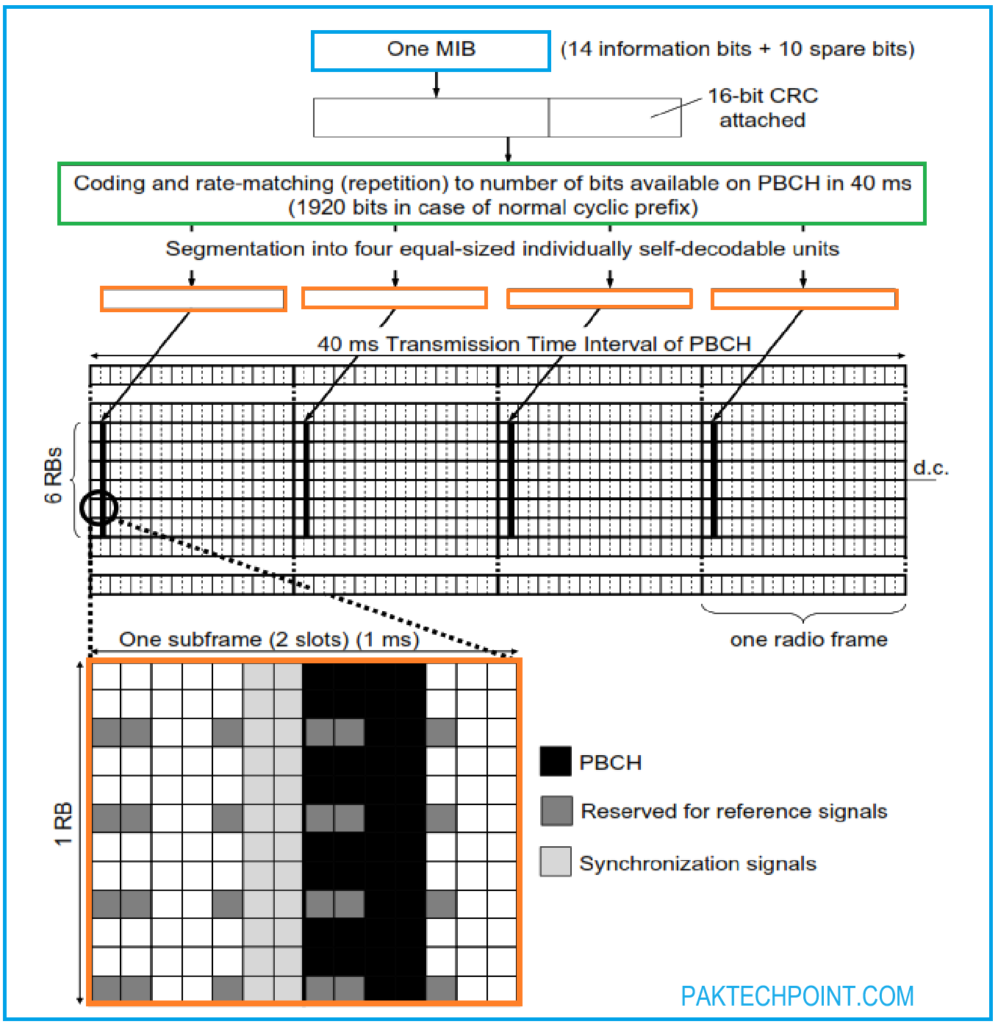In typical cellular systems like LTE, the Broadcast Channel (BCH) carries the essential system information necessary for configuring and operating other channels in the cell. The achievable coverage for BCH reception is crucial to the successful operation of such cellular communication systems, and LTE is no exception.
The Physical Broadcast Channel (PBCH) is a Downlink Data-Transporting Channels of LTE (Long Term Evolution) and 5G NR (New Radio) networks, serving a crucial role in the initial connection and communication between the user equipment (UE) and the network.
The broadcast system information have two categories:
Master Information Block (MIB):
- The MIB have of a limited number of the most frequently transmitted parameters essential for initial access to the cell. It is carried on the Physical Broadcast Channel (PBCH).
System Information Blocks (SIBs):
- The other SIBs, at the physical layer, are multiplexed together with unicast data transmitted on the Downlink Shared Channel.
This article focuses on the PBCH, which has unique design requirements.

Design Requirements of PBCH
- Detectable Without Prior Knowledge of System Bandwidth:
- The PBCH is mapped to the central 72 subcarriers of the OFDM signal, corresponding to the minimum possible LTE system bandwidth. This allows the UE to detect the PBCH without prior knowledge of the system bandwidth, as the UE identifies the system center frequency from the synchronization signals.
- Low System Overhead:
- The PBCH carries a minimal amount of information to reduce system overhead. The MIB size is just 14 bits, repeated every 40 ms, resulting in a PBCH data rate of only 350 bps.
- Reliable Reception:
- Reliability at the cell edges is achieved through time diversity, forward error correction coding, and antenna diversity.
- Time Diversity: The MIB transmission on the PBCH is spread over 40 ms, reducing the likelihood of a whole MIB being lost in a fade.
- Forward Error Correction: The PBCH uses convolutional coding with a basic code rate of 1/3 and a high degree of repetition, providing strong error protection.
- Antenna Diversity: Both eNodeB and UE may use antenna diversity. UEs are expected to have dual-antenna receive diversity. eNodeBs with multiple transmit antennas use Space-Frequency Block Coding (SFBC).
- Decodable with Low Latency and Low Impact on UE Battery Life:
- The low code rate and repetition allow the full set of coded bits to be divided into four subsets, each decodable in its own right. Each subset is transmitted in one of the four radio frames over 40 ms. If the Signal to Interference Ratio (SIR) is sufficient, the UE can decode the MIB from fewer frames, conserving battery life.
Detailed Operation of PBCH
- Resource Elements: The PBCH avoids resource elements used for reference signal transmission, regardless of the number of transmit antenna ports at the eNodeB.
- Transmit Antenna Ports: The UE determines the number of transmit antenna ports by performing decoding for each SFBC scheme, with the CRC masked with a codeword representing the number of ports.
- Timing of Transmission: The 40 ms transmission interval for each MIB on the PBCH is determined implicitly from the scrambling and bit positions, which are re-initialized every 40 ms. The UE can determine the timing by performing four separate decodings, checking the CRC for each.
Approaches for Decoding PBCH
- Simple Approach: Perform decoding using a soft combination of the PBCH over four radio frames, advancing a 40 ms sliding window until decoding succeeds. This may take 40–70 ms.
- Faster Approach: Attempt to decode the PBCH from the first single radio frame. If it fails, combine it with the next frame, repeating until successful decoding is achieved. This approach can be faster, potentially taking only 10 ms, but requires more complex logic.
The PBCH design in LTE ensures detectability without prior knowledge of system bandwidth, low system overhead, reliable reception even at cell edges, and low latency with minimal impact on UE battery life.
What is definition of PBCH?
What is transmission and structure of PBCH?
Repetition: The MIB carried by the PBCH is typically repeated several times (e.g., every 40 ms) to ensure that UEs can decode it even under challenging conditions.
Modulation and Coding: The PBCH uses QPSK (Quadrature Phase Shift Keying) modulation.